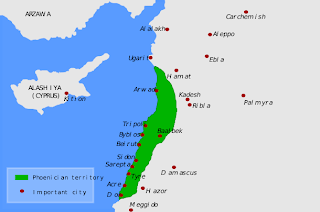Their Alphabet Started It All
The
Phoenicians were members of an ancient civilization based in the north of
ancient Canaan, which approximates today’s modern Lebanon. Their civilization was a trading maritime culture that spread across the
Mediterranean from 1550 BC to 300 BC, a period in history when there was no
major military power in Mesopotamia, thus enabling smaller states like
Phoenicia and the Hebrews to prosper.
The term “Phoenicia” was actually
from a Greek word that referred to the color of the dye from the snail murex; the Phoenicians, however,
referred to themselves as the “Kena’ani,”
(or “Canaanites”), which incidentally is also a Hebrew word for “merchant.”
Although the Phoenicians
considered themselves a single nation, Phoenicia was not a unified state but a
group of city-kingdoms, much like the ancient Greek city-states. The
most important of these cities were Simyra, Zarephath (Sarafand), Byblos,
Jubeil, Arwad (Rouad), Acco (‘Akko), Sidon (Şaydā), Tripolis (Tripoli), Tyre
(Sur), and Berytus (Beirut). The two most powerful were Tyre and Sidon, which
alternated as sites of the ruling power.
Called Sidonians or Canaanites in the Old Testament, they founded their
first settlements on the Mediterranean coast about 2500 BC. The Phoenicians
developed their culture under the influence of the Sumerians and Akkadians of
Mesopotamia. Around 1800 BC, the Egyptians invaded and conquered Phoenicia.
Raids on Egyptian territory by the Hittites around 1400 BC weakened the
Egyptians, providing the Phoenicians an opportunity to revolt; by 1200 BC they
succeeded in driving out the Egyptians.
Phoenicia comprised an area that is now modern Lebanon and parts of Syria
and Israel. As the territory was small, Phoenicians were forced to turn to the
sea for a living. They were the most skillful shipbuilders and navigators of
their time. They founded colonies all over the Mediterranean, even reaching as
far as Spain and the British Isles. Their most important colony was Carthage in
North Africa.
 |
| Hannibal, one of history's greatest generals, was from Carthage |
Monarchy was Phoenicia’s oldest form of government. Kings could not be
chosen outside the royal family, as members of the royal family claimed they
were descended from the gods. The king’s power, however, was not absolute.
Powerful merchants who possessed great influence in public affairs largely
limited the power wielded by the king. The kings in the cities of Byblos,
Sidon, and Tyre had a council of elders to assist them in their duties. Later,
other Phoenician cities adopted a form of republican government in place of the
monarchy. Instead of a king, a suffete,
or a judge, ruled some of these city-states.
With mountains to their east and the Mediterranean to their west,
Phoenicia’s geography proved ideal for trade during this era. The Phoenicians
were able to exploit the small arable land in the mountain slopes, and use the
watercourses for irrigation, a system of cultivation that was in use up to the
20th century. Phoenicia was also famous for its cedar and fir
forests, which provided neighboring countries with valuable wood, and for the
purple dye, the “Tyrean purple.” This dye, obtained from the snail murex, was so expensive that only kings
and members of the nobility could afford garments dyed with it. Ivory,
woodcarvings, linen, wine, metal works, and glass are some of the products that
were traded by these people. The invention of glass is also credited to the
Phoenicians.
A Phoenician king, Hiram, is also mentioned in the Old Testament as an ally of King David and later of King Solomon, whose temple King Hiram helped build.
They are also famous for their maritime exploits. Besides founding colonies
throughout the Mediterranean, there is also evidence of Phoenician mariners having reached the New World, well before Columbus did so in the 15th
century. After developing the technical knowledge for navigating the high seas,
the Phoenicians mastered almost all of the sectors of economy: from
exploitation of the mineral and agricultural resources, to their
transformation, and commercialization through a remarkable chain of
distribution.
Due to their sea-faring capabilities, they were able to reach many
markets, taking the fine wares of Eastern Europe to trade with the Western
barbarians. In addition, they learned to manufacture the wares themselves, and
they adapted to the taste of the buyers in different countries around the
Mediterranean Sea. This meant that they did not only offer luxury goods to rich
customers, but they also had low-priced goods for the masses as well. We can
say therefore that the Phoenician Empire was built not through military
exploits, but through trade.
The
Phoenicians’ maritime tradition would not have been possible without their
nautical technology. Their ships had designs that were pretty advanced for
their time, and their navigational skills where the envy of the ancient world.
In fact, they provided Persia with ships and mariners during Persia’s
unsuccessful attempt to conquer Greece. The Phoenicians were also the first to
use Polaris (the North Star) in navigation.
Probably the greatest contribution of the Phoenicians to humanity was
their alphabet, which was developed around 1000 BC at Byblos (incidentally,
from this city’s name comes the Greek word biblia—books—and the English word “bible”).
This 22-character alphabet greatly simplified writing; before this, people had
to create thousands of symbols for the thousands of words in their language.
The Phoenician alphabet uses the 22 characters to represent 22 different
sounds, which form a word when strung together. This type of alphabet is also
known as “phonetic” alphabet. Guess where the term comes from.
Phoenicians spread this style in their travels and greatly influenced
Greek and other alphabets.
Although Phoenician city-states never constituted a single political
entity, there was a cultural identity among the Phoenicians, mainly because of
a common language. In this society, wealthy merchant aristocrats enjoyed
protection from the law. Below the aristocracy were the lesser merchants,
artisans, and shopkeepers. A rung below the social ladder were the average
workers, and at the bottom were the slaves. Slaves had little protection from
the laws, but they could earn money and could even buy their own freedom.
Women in this society relatively had a bit more freedom than in any other
society of this era. They could initiate divorce proceedings, they could engage
in business, and they could bring issues to legal courts. Not much of a
freedom, though. Women were made to cover up carefully with layers of clothing
when going out in public, and were often relegated to work in menial jobs, like
weaving textiles. They had no say in government affairs.
Phoenicians are known for their pantheistic religion (belief in many
gods). Each city-state had its own special deity (kind of like a “patron”
deity), usually called Baal, or lord. A pantheon (temple) was presided over by
the chief god, “El.” The principal figure in Phoenician pantheons, however, was
Astarte (a.k.a. Ishtar).
 |
| In Phoenicia, she is known as Astarte |
The Phoenicians’ culture and language resemble those of the other Semitic
peoples living in the area. Because of their maritime tradition, they were able
to spread this culture to other places in the Mediterranean rim. Their art also
had no unique characteristics that could be identified as purely Phoenician;
they were heavily influenced by foreign artistic and cultural traditions, such
as the Egyptians, Greeks, Assyrians, and Persians. As a result, their art was a
mixture of the different styles of the many civilizations that conquered their
lands.
Phoenicia reached its peak shortly after they achieved self-rule with the
Egyptians’ expulsion from their lands. Their fleets traveled throughout the
Mediterranean and even reached the Atlantic Ocean. Other nations employed
Phoenician ships and mariners in their navies. Phoenicians also founded many
colonies, most notable of which, besides Carthage in North Africa, were Utica
(also in North Africa), Rhodes and Cyprus in the Mediterranean Sea, and
Tarshish in Spain. In the 8th century, Phoenicia, then under the
leadership of Tyre, was conquered by Assyria. After the fall of the Assyrian
Empire, the city-states were added into Nebuchadnezzar II’s Chaldean Empire. In
539 BC, they became part of the Persian Empire.
Alexander the Great then conquered the Persians; several city-states of
Phoenicia quickly surrendered to the Macedonian conqueror, except for Tyre.
Alexander conquered Tyre in 332 BC only after a seven-month siege. Phoenicia
gradually lost its identity after this defeat. The inhabitants were absorbed into
Alexander’s empire, and the cities became Hellenized (became Greek-like). In 64
BC, the territory became a province of the Roman Empire called Syria.
In the year 630, Islamic Arabs conquered the area of what used to be
Phoenicia, almost without any resistance.







Comments
Post a Comment
So, what do you think? Post it here: